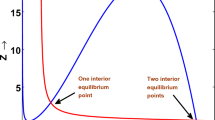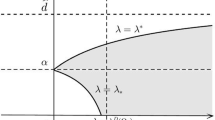Abstract
We consider an eco-epidemiological model consisting with toxin producing phytoplankton and zooplankton. In this model, only phytoplankton population is infected by some viral infection. So, the phytoplankton species is divided into two sub-species namely susceptible phytoplankton and infected phytoplankton with the assumption that viral infection is removable. Since infected phytoplankton is more weaker than susceptible phytoplankton, the capturing rate of susceptible phytoplankton is smaller than that of infected phytoplankton. As a result, zooplankton’s functional response for susceptible phytoplankton may be taken as Holling Type-II while the interaction between infected phytoplankton and zooplankton is governed by Holling type-I response. Also, zooplankton are always free from infection due to predation. Moreover, toxin producing phytoplankton are not only the food source for zooplankton but also depend on other food sources like bacterioplankton, small zooplankton etc. So, consideration of zooplankton as generalised predator is very significant ecological impacts in this work. Further, we assume that toxin liberation is not an instantaneous process, it is mediated by some time lag. We analyze the resulting model through various mathematical characteristics such as positivity, uniform boundedness, local stability and global stability. The system undergoes through different types of local bifurcations such as saddle-node, transcritical, Hopf which are of codimension-1 and cusp point, Zero Hopf, Bogdanov–Takens bifurcation which are of codimension-2 for the variation of suitable parameters. The model is incorporated with two different time lags due to toxin liberation and it is established that the time lags can destabilize system through the Hopf Bifurcation. We verify our analytical findings through numerical simulations using MATLAB.



























Similar content being viewed by others
References
Sellner KG, Doucette GJ, Kirkpatrick GJ (2003) Harmful algal blooms: causes, impacts and detection. J Ind Microbiol Biotechnol 30:383–406
Hallegraeff G (1993) A review of harmful algal blooms and their apparent global increase. Phycologia 32:79–99
Roy S (2009) The coevolution of two phytoplankton species on a single resource: allelopathy as a pseudo-mixotrophy. Theor Popul Biol 75(1):68–75
Ferson S (1990) Biological delay systems: linear stability theory. N. Macdonald. Q Rev Biol 65(3):348–349
Shokrgozar A, Safarpour H, Habibi M (2020) Influence of system parameters on buckling and frequency analysis of a spinning cantilever cylindrical 3D shell coupled with piezoelectric actuator. Proc Inst Mech Eng Part C J Mech Eng Sci 234:512–529
Hashemi HR, Alizadeh A, Oyarhossein MA, Shavalipour A, Makkiabadi M, Habibi M (2019) Influence of imperfection on amplitude and resonance frequency of a reinforcement compositionally graded nanostructure. Waves Random Complex Media. https://doi.org/10.1080/17455030.2019.1662968
Ebrahimi F, Mohammadi K, Barouti M, Habibi M (2019) Wave propagation analysis of a spinning porous graphene nanoplatelet-reinforced nanoshell. Waves Random Complex Media. https://doi.org/10.1080/17455030.2019.1694729
Mondal S, Maiti A, Samanta GP (2018) Effects of fear and additional food in a delayed predator–prey model. Biophys Rev Lett 13(4):157–177
Mondal S, Samanta GP (2019) Dynamics of an additional food provided predator–prey system with prey refuge dependent on both species and constant harvest in predator. Phys A Stat Mech Appl 534:122301
Mondal S, Samanta GP (2020) Dynamics of a delayed predator-prey interaction incorporating nonlinear prey refuge under the influence of fear effect and additional food. J Phys A Math Theor. https://doi.org/10.1088/1751-8121/ab81d8
Mondal S, Samanta GP (2020) Dynamical behaviour of a two-prey and one-predator system with help and time delay. Energy Ecol Environ 5:12–33
Mukhopadhyay B, Bhattacharyya R (2008) Role of gestation delay in a plankton–fish model under stochastic fluctuations. Math Biosci 215:26–34
Cui G, Yan X (2011) Stability and bifurcation analysis on a three-species food chain system with two delays. Commun Nonlinear Sci Numer Simul 16(9):3704–3720
Wang J, Jiang W (2012) Bifurcation and chaos of a delayed predator–prey model with dormancy of predators. Nonlinear Dyn 69:1541–1558
Sharma A, Sharma A, Agnihotri K (2016) Bifurcation behaviors analysis of a plankton model with multiple delays. Int J Biomath 9:04
Mondal A, Pal AK, Samanta GP (2020) Rich dynamics of non-toxic phytoplankton, toxic phytoplankton and zooplankton system with multiple gestation delays. Int J Dyn Control 8:121–131
Xiao Y, Chen L (2001) Modeling and analysis of a predator–prey model with disease in the prey. Math Biosci 171(1):59–82
Sharma S, Mondal A, Pal AK, Samanta GP (2018) Stability analysis and optimal control of avian influenza virus a with time delays. Int J Dyn Control 6:1351–1366
Beltrami E, Carroll TO (1994) Modeling the role of viral disease in recurrent phytoplankton blooms. J Math Biol 32:857–863
Holling CS (1959) Some characteristics of simple types of predation and parasitism. Can Entomol 91(7):385–398
Holling CS (1965) The functional response of predators to prey density and its role in mimicry and population regulation. Mem Entomol Soc Can 97(S45):5–60
Das M, Samanta GP (2020) A prey-predator fractional order model with fear effect and group defense. Int J Dyn Control. https://doi.org/10.1007/s40435-020-00626-x
Gakkhar S, Singh A (2010) A delay model for viral infection in toxin producing phytoplankton and zooplankton system. Commun Nonlinear Sci Numer Simul 15(11):3607–3620
Agnihotri K, Kaur H (2019) The dynamics of viral infection in toxin producing phytoplankton and zooplankton system with time delay. Chaos Solitons Fractals 118:122–133
Ma Z, Wang S (2019) A generalized predator–prey system with multiple discrete delays and habitat complexity. Jpn J Ind Appl Math 36:385–406
Samuelson PA (1971) Generalized predator–prey oscillations in ecological and economic equilibrium. Proc Natl Acad Sci USA 68:980–983
Dhooge A, Govaerts W, Kuznetsov YA (2003) Matcont: a matlab package for numerical bifurcation analysis of odes. ACM SIGSAM Bull 38:21–22
Corduneanu C, Li Y, Mahdavi M (2016) Functional differential equations: advances and applications. Wiley, New York
Ross SL (1984) Differential equations. Wiley, New York
Perko L (2001) Differential equations and dynamical systems. Springer, Berlin
Strogatz SH (1994) Nonlinear dynamics and chaos. Addison-Wesley Publication, New York
Murray JD (1993) Mathematical biology. Springer, Berlin
Acknowledgements
The authors are grateful to the anonymous referees, Prof. Jian-Qiao Sun (Editor-in-Chief) for their careful reading, valuable comments and helpful suggestions, which have helped them to improve the presentation of this work significantly.
Author information
Authors and Affiliations
Corresponding author
Ethics declarations
Conflict of interest
The authors declare that they have no conflict of interest.
Rights and permissions
About this article
Cite this article
Sahoo, D., Mondal, S. & Samanta, G.P. Interaction among toxic phytoplankton with viral infection and zooplankton in presence of multiple time delays. Int. J. Dynam. Control 9, 308–333 (2021). https://doi.org/10.1007/s40435-020-00646-7
Received:
Revised:
Accepted:
Published:
Issue Date:
DOI: https://doi.org/10.1007/s40435-020-00646-7




